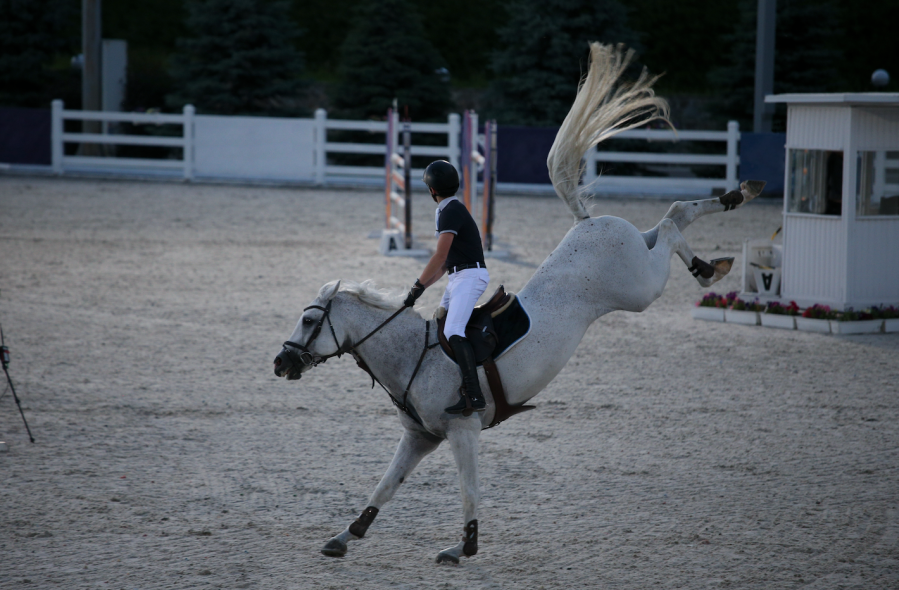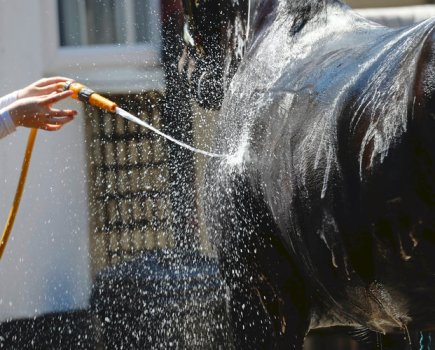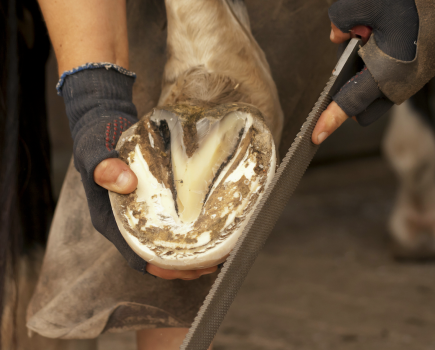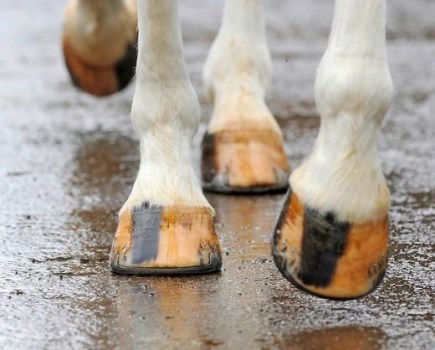When trying to work out how to stop a horse from bucking, the question you should really be asking is why your horse is bucking in the first place.
Horses like to move their bodies. Watch them playing and letting off steam in the field and chances are you will see them kick up their back heels. A buck can be a sign of exuberance — sometimes they roll and when they get up they buck as if to stretch.
Young horses play fight and dash around each other, bucking and spinning as part of the game.
When a horse bucks with a rider on board, though, we need to sit up and ask: ‘Why?’
Playful horse behaviour like a buck in a moment of excitement or frustration can be unsettling for any rider, as though you are at the top of the rollercoaster not knowing how things will feel next.
In the moment you need to try and relax so you can respond and guide the horse forward.
It needs to be a subtle combination of riding positively forwards and helping the horse regain their balance so that you re-establish calm.
Why is my horse bucking?
I want to return to the question of why your horse might be bucking before we explore how to stop a horse bucking.
Horses are prey animals who are hard wired to run, twist and turn themselves inside out to escape.
A horse in pain will begin to react to that pain by trying to escape from their perception of the source of pain.
This is why a horse with a sore back is an obvious candidate for bucking.
So, if your horse starts bucking, the first thing you need to do check is whether your saddle fits your horse and puts you in a good balance.
It’s also possible that your horse is in pain in another part of their body and is reacting in the moment to some discomfort.
Are they in pain?
Always make sure your horse is not in pain or discomfort from tack that doesn’t seem to suit them by working with a qualified saddle fitter.
They will assess the horse standing square and take templates to record the shape of the back.
Then they will look at your saddle and assess its balance and shape before seeing it on the horse without a saddlecloth.
Your saddle fitter will be watching the horse’s expression and behaviour for any small clues that suggests the horse isn’t feeling comfortable, and what could be causing them to buck.
When they do the girth up, the saddle fitter will be watching for a reaction from your horse.
They will also discuss with you how your horse is feeling in general and if you have any concerns. For example:
- Does your saddle slip?
- Does your horse work confidently in all three paces and in the transitions?
- Has anything changed recently, such as a loss of balance in transitions?
- Do they tend to rush around when ridden?
- Are there particular moments that triggers the horse to start bucking, such as hacking out in company?
What’s normal for your horse?
Talking about your horse and noticing their reactions is a good habit to adopt.
This helps you paint a picture for people who are supporting you and your saddle fitter will use all the insights you share to assess the situation and understand your partnership.
It’s also useful for you to practice observing your horse’s reactions and to be able to describe what you have noticed in hand, in the stable and field, and when you’re in the saddle.
The ridden part of a saddle fit is about showing how you and your horse work together.
You need to show straight lines, turns and generally ride as you would normally.
It’s not a test, so for example, if you are not happy cantering for whatever reason, explain that you will only show walk and trot.
Trust your instincts about how you feel in the saddle. If something doesn’t feel right or your horse is telling you that they are not comfortable, say so.
Sometimes it takes a few visits to find the tack that suits you both.
Other reasons for bucking
There are other issues to rule out too.
Does your bridle fit your horse?
Is your horse up to date with dental checks and are they content in the contact?
Regular dental checks will help make sure your horse is not uncomfortable or suffering from sharp teeth or uneven wear causing the jaw to become misaligned.
If you suspect your horse is in pain or discomfort talk to your vet. They will be best placed to assess if your horse is in pain and to decide on the treatment plan.
Explain what signs and behaviour you have noticed and discuss your concerns about your horse’s way of going.
Give as much information as you have.
Maybe you realise that they only seem to be rolling on one side or are struggling to get up after lying down.
The small things you have seen might be totally unrelated to ridden work, but remember you know your horse and their routine.
This makes you a critical part of helping your vet to work out if things have changed or if something is hurting.
How to stop a horse from bucking
When you have eliminated the possibility that your horse is bucking because they’re in pain, think about the following:
Are they getting enough turn out?
If they are stood in a stable all day, bucking could be the horse’s way of releasing excess energy.
Are they ridden regularly?
If not, they may be bucking because they’re excited, nervous, or feeling fresh.
What are you feeding them?
A diet providing more energy than they need to fuel their work can lead to behaviour like bucking.
Speak to a nutritionist for advice.
Are they excited?
Perhaps they’re approaching a jump, warming up in a buzzy atmosphere at a competition, anticipating cantering in an open field, feeling jolly when being ridden with other horses…
Are they cold?
Using too much leg too soon on a cold day or before they have warmed up properly could trigger a buck, for example.
Are your aids clear?
Perhaps they’re bucking because they’re confused by what you’re asking.
Are they kicking out?
This could be the case if something has spooked them or other horses are getting too close.
Could it be a training issue?
Something as simple as breathing after being tacked up and feeling the girth…
Is it a learned habit?
Clever horses may work out that a buck causes you to fall off (or dismount).
Is it a bad habit?
Bucking when you ask for canter in a certain corner of your training field or arena, for example.
What sort of buck is it?
A one-off ‘whoopee!’ because they are excited or a series of bucks as a warning sign that something is wrong?
If you can identify any of the above as a possible cause (NB this list is not exhaustive), it will be key in working out how to stop a horse bucking.
What to do if your horse bucks
If you feel like a horse you are riding is about start bucking, how you respond is key to being able to sit tight and stop them doing it.
First and foremost, keep their head up. Horses need to put their head down to really buck.
Should the bucking start, it’s important you lean back with your upper body and keep your lower leg secure.
Don’t let your lower leg slip back (it’s better to push it forward, if anything) because this will unbalance you.
As soon as your upper body to tip forwards and your lower leg slips back, there’s a good chance that you will end up on the floor. This is not how to stop a horse bucking.
Bucking in front of a fence
I have ridden a few horses who bucked. The first that comes to mind is a young Appaloosa mare.
We clicked immediately and I trusted her, even though at time she was a little behind the leg (borderline lazy) with no real ‘go’ button.
Then I discovered that she loved jumping. She was able to make a lovely shape over a fence, but she liked to jump on her own terms.
After a few months, the mare started bucking before a fence. It was nothing alarming, and mostly she was able to rebalance and pop the fence.
Circling in front of the fence made things worse, because it built up more anticipation and excitement to get to the jump.
Eventually, I managed to reduce the bucking by having a bigger and more forward canter in the approach.
Reflecting on everything this horse taught me, I still don’t care for the feeling of bucking before a fence.
However, I have learned to concentrate on the quality of the canter and let the fence come to me.
Bucking because they’re in pain
A very different horse I used to ride started bucking because they were in pain.
This gave me a completely different and scary feeling as a rider.
If you find yourself in this situation, whether you are riding a horse you know or one that is new to you, there is a technique I use to try and de-escalate the situation.
Firstly, force yourself to breathe and try and bring the horse around in a circle.
It won’t necessarily stop the horse bucking, but it’s going to give them a sense of direction of somewhere to go while giving you a chance to put your inside leg on and squeeze your outside rein gently to try to re-establish communication.
When a horse is in pain, they might not be listening to you or thinking about anything except escaping that pain.
You need to stay calm and work out what you need to do to be safe.
- Does it feel as though the horse has their back up?
- Are they clamping their tail or swishing it around angrily?
- Look at their ear position: are they pinned back or fixed forward with their attention everywhere but on you in the saddle?
- Are they listening to your leg or are they getting crosser?
You need to decide whether this is something that you can cope with and safely ride through, or if your goal is to finish the ride asap and quietly dismount.
Listen to your horse
The horse I’m remembering had a change in character that let me know something was wrong.
Even dismounting became tricky, as he tried to let me know about a problem with the saddle.
When this was changed, I had to reintroduce riding slowly, because we both remembered the bad experience.
I have ridden a lot of young horses and know my limitations, but I trusted this horse.
We went slowly and had moral support on the ground. As soon as I was able to make a connection on the circle and he realised going forward was fine, we both relaxed and put it behind us.
It’s possible that you rule out all causes of pain and you can find no reason for the bucking, yet the horse still feels dangerous to ride.
As a coach and a rider who has been there and had a few falls I’d rather forget about, my advice is to talk to a professional (perhaps an instructor or trainer or a trained and more experienced riding friend).
Ask them to assess your horse and help you make a plan that keeps you safe.
Working with a horse who bucks
There is no shame in saying I don’t feel comfortable riding a particular horse. One horse that I adored riding was sharp but kind.
He was reactive and could have a buck, but it had the feeling of flying over a large fence rather than potentially catapulting me out of the saddle.
The way I learned to manage and ride him through is a good example of how to work with a horse who bucks.
When he landed from a fence and I tried to shorten the canter, he would buck.
I had to learn to leave him alone and use subtle half-halts to maintain the balance while still allowing him to go forward and enjoy himself.
Stopping his bucking behaviour was simple.
My job as a rider was to stay with him and gradually shorten the canter and give him something else to think about, such as a couple of steps of leg yield to remind him he had a rider.
By adding in movements like this to give the horse something to focus on, rather than thinking I was interfering with his desire to jump, he didn’t feel the need to buck anymore.
It is important with eager horses like this to recognise their bucking triggers:
- Freshly clipped?
- Feeling fit?
- Riding out early in the morning with a slight chill in the air?
- A flapping exercise sheet?
- A pigeon flapping in their eye line?
Any of these could easily set my horse off, and there are other similar horses out there.
Trying to shut down a horse’s ‘forward’ too soon will cause them to simmer like an angry pressure cooker with their mind suspicious of everything real and imagined.
Confidence is key
You know your horse and what your relationship is like. If you feel unwell at the prospect of getting on, I can empathise with that.
I have ridden some horses that could have happily gone onto have a successful rodeo career with no need to wear a bucking strap.
I quickly learnt that these are not the sort of horses I want to ride for work or pleasure.
Some horses buck, and unless it’s caused by pain or a training issue that can be sorted out, they probably always will. Other horses never buck.
Why some horses don’t buck is a rather complex question. It can be as simple as making sure they have the lifestyle and management routine that suits them and makes them happy.
It could be that they enjoy their work and understand the questions being asked so that all is right with their world.
Some horses just like to buck!
Don’t take it to heart if you find yourself with a horse who likes to buck. Some do — and they always will.
All you can do is learn to sit the bucks or, if it really scares you, consider whether this is really the right horse for you.
My top tip is that while you are working out the way forward in a training or rehabilitation programme, book yourself some lessons at an approved riding school so that you can build your confidence.
Talk to your coach about your options and don’t be afraid to ask for help to manage the behaviour.
Doing so confidently and competently is key to working out how to stop a horse from bucking.
Your job as a rider is to give clear and consistent aids and to remain in balance with your horse.
You need to be confident that your horse is comfortable, willing and able to do what you’re asking.
You also need to be patient with yourself and your horse as you work towards developing a partnership.
Good luck.
Main image © Your Horse Library/Kelsey Media








